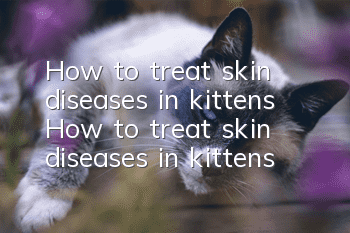How to treat skin diseases in kittens How to treat skin diseases in kittens

How to treat skin diseases in kittens? In addition to parasites and infectious diseases, the most troublesome problems for kittens are skin diseases and abdominal bloating. If you want to raise a kitten well, you still need to carefully understand the solutions to these problems. of.
1. Flea allergy dermatitis: As the name suggests, it is caused by small red papules appearing in the wound after a flea bite. The wound appears after the cat scratches it due to itching. Sometimes the wound will be combined with mold and bacterial infection, making the lesion area The more it expands, the bigger it gets.
2. Scabies: This is a type of scabies that first parasitizes in the ears, then attacks the head, and then the whole body. When this insect eats animal dander tissue, it will cause intense itching, so when If you find that the kitten keeps scratching its ears and shaking its head, you should pay attention. It may even have scabs, ulcers, pustules... Please stop "observing" and send it to the hospital for treatment!
3. Ringworm: Cats under one year old are easily infected with ringworm, which is a special kind of mold. The typical symptoms are irregular round hair loss areas, mixed with scaly spots and scars, and sometimes allergies. Sexual papules, this kind of ringworm is highly contagious and common to humans and animals. Once discovered, it must be treated and controlled as soon as possible.
If the kitten has suffered from skin diseases, its related utensils should be thoroughly disinfected, and the surface should be scrubbed or sprayed with 0.5% bleach. If the kitten is exposed to sunlight for 5 to 6 hours a day for one week, the effect will be seen. It will be better, it is best to expose it to the sun until the cat recovers from treatment. Since mold will survive in the form of spores, after the cat treatment is effective, it will continue for about one week to ten days. The same goes for disinfection of utensils, so as to avoid the chance of recurrence. Otherwise, the remaining mold spores can still survive and lurk for up to 3 days. ,4 years.
- Why does the kitten keep eating with its bulging belly?
- What should kittens eat if they don’t have teeth? Cat Feeding!
- Will a cat's personality change after being neutered?
- What are the advantages and disadvantages of owning a cat?
- Does it mean there are bugs when a kitten is itching?
- How to remove cat lice? Don’t you know yet?
- Is catnip harmful to cats? What will happen if a cat smokes catnip?
- Things to note when breeding British Shorthair
- The historical development and personality characteristics of the British Bobtail Cat
- Do I need to be vaccinated if I am scratched by a cat and bleed?



